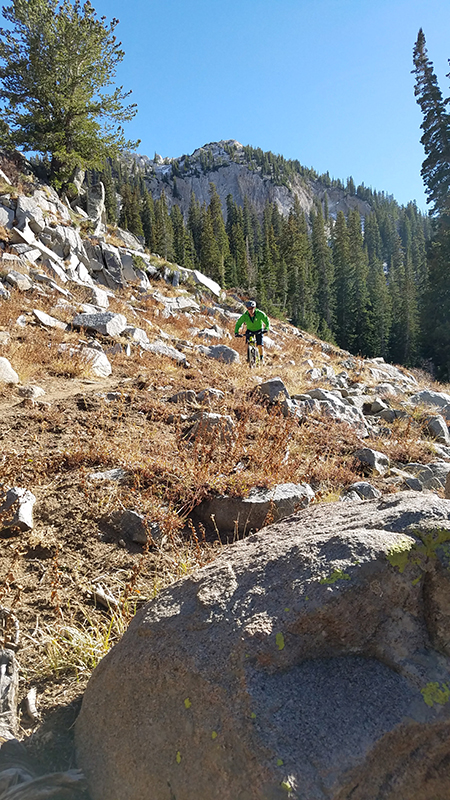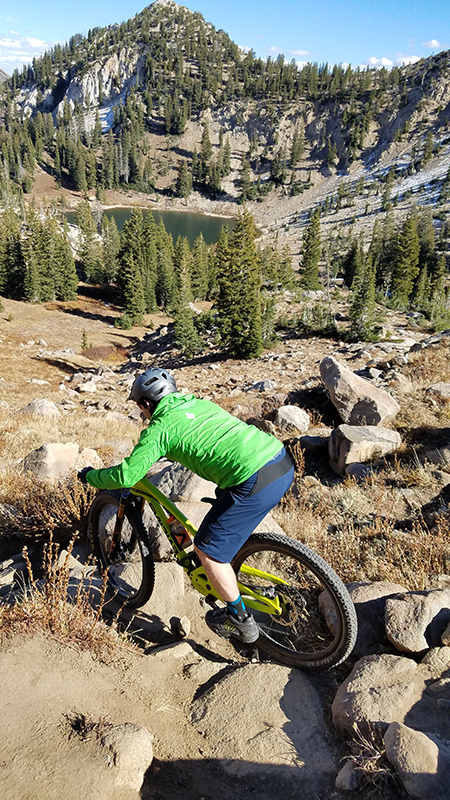
Fox Transfer Dropper Post
Stated Features:
- 5 inches / 125 mm of infinite travel
- Nitrogen charged, sealed design
Stated Weight: 517 grams, post only
Blister’s Measured Weight:
- Total Weight: 618 g
- Under bar lever: 28 g
MSRP:
- Post: $314
- Lever: $65
Reviewer: 5’8” 160 lbs
Days Tested: 18 days
Test Location: Park City, UT
Intro
The previous Fox dropper post, the DOSS, was well liked by those that used it due to its reliability. However, it had a funky, complex lever, only three height positions, and no stealth routing option. So, many riders were dissuaded from buying it, myself included.
Enter the new Transfer post. It has a simple design with stealth routing, infinitely adjustable positioning, and a very clean-looking dropper post lever. The timing of the release of this follow-up dropper post design feels a bit slow, but perhaps it is hitting at a time when riders are tired of the relatively short service intervals of most other posts.
Having heard the stories about the reliability of the Fox DOSS dropper I was excited to get on the Transfer
Options
The Fox Transfer is offered in two finishes: Kashima or Black, and it comes in two diameters: 30.9 mm and 31.6 mm. You can purchase it in 3 different drop options: 100, 125, or 150 mm, all offered in either stealth or external cable routing. Fox sells two different levers, one designed to take the place of a front shifter under the bar, and one that is compatible with a front shifter. The clamp is a two-bolt design.

The spring is nitrogen-charged and Fox does not encourage home service of the post. That is a disadvantage, but they suggest that the service interval should be longer than most other posts. I can’t seem to find an actual interval listed anywhere. The minimum extended height of the post is ~7.25”, slightly longer than a KS Lev Integra post.
Cables, Housing, and Installation
Cable install was easy and very similar to that on the Thomson Covert dropper. The plug on the end of the cable attaches to the post and the cable terminates at the bar. This makes it easier to adjust cable housing length and to adjust cable tension. The mechanism holding the cable end at the bottom of the post is as well designed as the one on the Thomson Covert and definitely more convenient than the design used on KS posts. Unlike the KS posts, the cable length does not need to be precise and you do not need to try to attach a set screw-anchored barrel to the fraying cable end.
Fit & Feel
The post-seat interface itself is very reminiscent of the Thomson Covert post as well as all fixed length posts that Thomson has been manufacturing for years. The clamp mechanism is near identical, another forged aluminum 2-bolt design with large barrels on the top to help distribute load. The similarity is great news as the Thomson clamp is robust and creak free. The only downside is that an L-shaped allen key is necessary to adjust the bolts on the clamp because they are parallel to the post shaft making it so a t-handle hits the post when you attempt to turn it. Also, if you are looking for an offset post, you’ll have to look elsewhere.
The lever is a nice unit too (whichever option you choose). The dimpled design offers good grip. It is pretty small, but still easy to stab at. It is generally shaped like a shift lever if one were to take a dremel tool and grind the lever into a smaller square, 1 cm on a side. It plays quite nicely with brake levers and has a moderately long throw.
I used the under bar mount. The shifter compatible version looks nearly as satisfactory for those that want to use a front derailleur.
The kashima coating matches the Fox fork coating well and looks good. They also offer a less expensive all black version. As far as I can tell, the only difference is the coating. While it’s meant to reduce stiction I don’t see it mattering as much for a post.
There is a bit of rotational play at the top of the stroke, slightly more than a new Thomson post, but less than a Reverb or KS Lev. I don’t find any fore-aft play though. I’ll be eager to see if the play changes as it wears in.
The Lever
The lever design is great. Fox sells the post without a lever and you get to choose which design you’d like to buy.
The shifter compatible version is nicer than the KS Lever, with full aluminum construction and a slimmer design that places the lever in a more convenient to reach location. That said, I do find the construction and ergonomics of the Thomson lever to be a bit nicer still.
The under bar mount version of the Fox lever is great. Since I don’t run a front shifter, I find it to be much preferable to a shifter compatible design, even a really nice one like the Thomson lever. But, it isn’t as nice as the larger Specialized under bar mount levers or the Race Face Turbine shifter-style lever. I find both of those more comfortable to use and easier to stab at in technical situations. However, the Fox lever is good enough that I don’t find myself pining for either.
Going Up, Going Down
The action on the Transfer feels comparable to the Covert (I think I’m starting to sound like a broken record here). It is definitely more damped than a post like the KS Lev or the Specialized Command Post. One of the advantages of that though is that I could modulate the action and stop the post at different positions on the return stroke. Not a critical feature for me, but pretty nice.

There is a nice clunk that lets you know that the post as reached the top of its stroke, but it isn’t as terrifying as the slamming clunk noise that a post like the Specialized Command Post makes.
Overall, I’m happy with how quickly the post returns, how easy it is to tell if it reaches the top of its stroke, and how much resistance there is to pushing the post down. That’s important because the pressure / stroke speed is not adjustable.
NEXT: Durability, Comparisons, Etc.
